Generally stretch ceiling in the corridor will look enough ...
|
|
Foam is in wide demand in the building materials market. Among him ... |
Glass blocks are hollow glass bricks that are widely used in ... |
How to paint the ceiling with acrylic paint
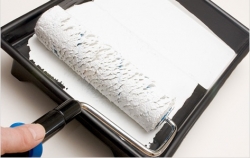
It is customary to start any repair work with the ceiling, because one drop of paint is enough for damage to freshly worshiped wallpaper or expensive flooring. The days were already sunk into oblivion when the only type of ceiling finish was its whitewashing. Today, painting the ceiling with acrylic paints allows you to emphasize the interior virtues by performing the surface in any color tonality and decorating with an original ceiling baseboard.
Content:
- Advantages of acrylic colors
- The choice of acrylic paint
- Surface preparation
- Mixing paint
- The choice of tools
- Painting technology
Advantages of acrylic colors
The most popular and universal coloring substances for the ceiling are acrylic -based paints. Acrylic colors have many advantages, which is why they occupy a leading position in the market among other substances. Consider them in more detail.
- Acrylic paint is resistant to pollution and elastic, which means that it allows you to block the smallest cracks to 0.5 millimeters. For this purpose, it is customary to apply paint in several layers.
- This is one of the most persistent substances to abrasion and ultraviolet radiation, so it does not lose its original color over time.
- Acrylic compositions are not afraid of moisture, so the ceiling painted with acrylic paint is easy to wash and remove dirt from it. Also in this regard, it can be used in rooms with increased humidity, that is, in bathrooms and other raw rooms.
- Acrylic paint is resistant to friction, calmly tolerates high temperature, it is also inherent in a fiery effect, so it can be used in the kitchen.
- Since acrylic paint refers to the water -based group, it is not characterized by an unpleasant pungent smell, which is inherent in all coloring compounds based on an organic solvent.
- Acrylic paints are quite simple in applying and dry very quickly, but you need to remember that acrylic darkens after drying.
- The process of staining the surface with acrylic paint will not take much time from the owners and take a lot of effort.
- Acrylic paint is economical in costs and has a fairly acceptable price. The price of acrylic paint for the ceiling ranges from 200 to 800 rubles.
- As for the color palette, there will be no unsatisfied consumers, because the number of shades of acrylic paint can please the most exquisite buyers.
The choice of acrylic paint
At the moment, the best paint is acrylic water -based, which is carried out on the basis of acrylic resins. Its undeniable advantage lies in high strength and elasticity. A more affordable option is vinilakril, acrylilicon and styrecryl compounds made on the basis of acrylic copolymers.
Modern acrylic paint is many types of compositions that differ in their consistency and composition. There are paints that are intended for painting ordinary dry rooms and paints for bathrooms with increased properties of moisture resistance. It is not recommended to use these substances for other purposes, if the composition is intended for a dry room, it is necessary to use it there.
A solution of acrylic paint for the ceiling is most often sold in white, however, you can achieve the desired shade with the help of special kings: depending on the level of saturation, it is customary to add the required number of tubes with the mixture. Also on sale there are brands of acrylic paints with ready -made colors and shades.
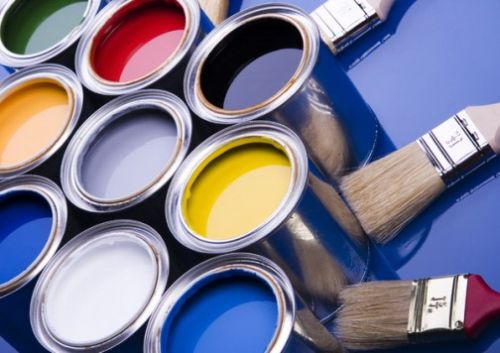
In the level of whiteness, all acrylic paints can be divided into 3 conditional. This is white, super-bud and milky white colors. For painting the ceiling, it is better to purchase the maximum white paint. However, remember that some manufacturers at a jar with milky -white paint write white, while others and on superbly write that this paint is white.
Therefore, ask the seller’s store to open the lid of the widier with the paint and compare the color color in a bucket with a leaf of white paper, which is used for a printer that should be taken with you. If the whiteness is similar, then such a substance is suitable for painting the ceiling. When the seller does not go to the meeting, then say preliminarily that you need the maximum whiteness, and that you will return the jar if this is wrong.
After drying, an acrylic suspended ceiling has a glossy or matte surface. But when choosing a paint, remember that the maturity for the ceiling is a very important indicator along with its whiteness and acts as one of the criteria of its impeccable appearance. The more matte surface you have, the different defects will be less noticeable on it, for example, various irregularities or unevenness of applying paint layers.
But if you want to make a colored ceiling, it is better to use glossy paints. This composition is advisable to choose if your ceiling is perfectly even and has a large quadrature. Also take this paint if the room is non -residential. Among domestic and imported manufacturers, the products of Dulux, Tikkuril, Siro Mat Plus, Innatak, Himaton, Himos, Svyatozar, Supermatt, have high quality.
Surface preparation
Before painting the ceiling with acrylic paint, close the floor and all the furniture with plastic film or newspapers, so as not to stain these surfaces during the preparation of the ceiling and its painting. For this reason, put unnecessary clothes, rubber gloves and a headdress.
Then you should clean the ceiling from old whitewashing and dust. To do this, periodically wetting a roller or brush in warm clean water, go through the entire area. Continue a similar process of cleaning, while the water in which the roller or brush drops will not stop clouding. Pay special attention to the joints of the ceiling with walls and angles, they should be washed with a brush.
If the ceiling is semi -machine or glossy, then it is recommended to add a little detergent to the water and process the ceiling with sandpaper with grain number 8 after washing. If there are deepening and cracks on the surface, then you need to close them by opening with a spatula, cleansing and smearing with putty.
After that, you need to primer the surface. The primer is necessary to increase the clutch of the ceiling with the future coloring composition, ensure the durability of the coating and prevention of the formation of fungus and mold. Remember that you need to select putty and primer so that they are completely compatible. Since the ceiling needs to be painted already smooth and even, be sure to clean the dried putty with sandpaper to create the surface of the rough texture.
Also, before painting the surface with acrylic paint, perform intermediate decoration of the ceiling in pre -prepared elements. You can buy sockets, baguettes, borders and other parts in the market or in a construction store, it is also possible to independently make such a decor from improvised materials.
Mixing paint
The result of your work depends on whether it is correct or not prepared or not prepared or not prepared. Remember that thick paint is not able to hide the joints between the stripes of painting. At this stage, dilute the paint with water to the consistency, which is recommended by the manufacturer, and mix it with a mixer, as shown in the video about painting the ceiling with acrylic paint.
If the manufacturer recommends adding water to the paint, as a rule, it will need no more than 5-10%. It happens that the paint does not require it to be bred, then it is written simply: mix, so simply mix the substance with great thoroughness. If it is supposed to paint the surface in one layer, then such mixing will be enough. The best option is to breed paint to a state of milk.
If a film arises on the surface, then it should not be mixed with the rest of the paint, since dried paint is not able to dissolve. As a result of such mixing, composition with lumps is obtained. Therefore, it is recommended to gently extract the film, and strain the remaining substance and only then mix. You can add additional components against the fungus, which are highly resistant to washing.
The choice of tools
When choosing how to paint the surface, you can stop your choice on a roller or brush. Each tool has its own features. The use of the brush is justified in small areas. On the ceilings of a large area, it is better to use a roller. Let's figure out how to paint the ceiling with acrylic paint with a roller and a brush.
Work with a brush
So that the paint does not flow down the brush during operation, you can attach a foam roller to the handle slightly below the brush itself. The brush when stained should be kept at a small angle or strictly perpendicular to the surface. Diping the brush in the paint, make sure that the bristles do not touch the bottom, otherwise the tool is deformed. When taking it out, tap on the edge of the dishes, removing excess paint from the bristles in this way, but in no case can you wipe the brush on the container.
Do uniform waves to make wide stripes, after which these stripes should be shaken. Keep the handle of the brush as close to the surface as possible, and as you move, increase the angle of inclination.
If the smoothness of the surface is important to you, then try to apply the strokes, crossing them. You need to do two smear - the first up and down, and it is recommended to draw them in one section. When using the brush, it is necessary to rotate it periodically around the axis in order to prevent uneven wear of the bristles. It is also recommended to squeeze the paint in the process.
When taking breaks in the work, do not leave to dry the brush, it will be stiff and will become unsuitable for further use. Having finished painting the ceiling with acrylic paint, you should thoroughly wash the brush so that there is no coloring composition left on it. Most often used for these turpentine or white spirit.
Work with a roller
When choosing which roller to paint the ceiling, you need to proceed from the dimensions of the room, the size of the tool in any case should correspond to it. It will be more convenient to work with a roller if pouring acrylic paint into a special container. In a similar pan, pour the paint to about half. The roller should be fully soaked during the dive.
After dipping the tool in a container with paint, roll it on a non -working surface with a net, bath or a piece of wallpaper or unnecessary linoleum. This will allow more uniformly to distribute the coloring composition on the surface of the roller and resulting in a homogeneous coating. If you ignore this, then the so -called non -coloring will form on the ceiling that they form ugly spots on a dried surface.
The process of applying paint start at a distance from the corner by about one meter. The start of work consists in distributing a plentiful layer of paint on the surface. The roller should be carried out from yourself. When using the roller, the strokes are crossed to each other, so the paint layer will be more uniformly distributed over the surface, and there will be no traces of the roller.
Painting technology
Now let's figure out how to paint the ceiling with acrylic paint. The smoothness of the surface will depend on the fact with which you press on the brush. The weak pressure will provoke that the paint will lie down with narrow stripes, the layer will be thick and with passes. And a strong pressure will lead to the formation of the drones, but the resulting layers will be thinner.
If you paint the ceiling with acrylic paint for the first time, it is recommended for yourself to choose a testing ground somewhere in the country. You need to use a slight pressure, increasing it as you spend paint.
It is better to start with the corners, using a special brush, so as to paint well and not miss unrelated areas. On the other hand, try to apply only one layer during one movement and not block the already painted places. Otherwise, the areas excellent in color will arise on the ceiling. It is recommended to move in one direction.
The next layer is applied perpendicular to the first. And then it is recommended to smooth the paint and joints, for this, draw a roller or a brush without paint. Before dyeing the ceiling for the second time, evaluate a freshly painted surface from another angle. Immediately correct the not painted places found, and if the paint already dries, then indicate these places, and during the next painting try to paint these areas first of all.
However, it is impossible to smear unexpressed areas with thicker paint, it will be worse. The repeated layer should be liquid so that it turns out to be a little blurry and eliminate defects with this. But the places that are painted twice are treated with an almost dry roller.
After applying the first layer, it is more reasonable to wait until the first layer dries. Carefully read the instructions, it indicates the period that should be withstanded between applying the paint layers. Each layer is applied only after the previous one is completely dry.
If you start applying the second layer on a damp surface, then the first may be blurred. Repeat the painting again, and apply the latter in the direction of the light, following that there are no joints. The ceiling is rarely covered with one layer of acrylic paint. Apply the composition of foreign production in two layers, but the domestic only in three layers.
After applying acrylic paint to the ceiling, it is recommended to wait time (a couple of hours) and make sure that the entire surface is covered with paint and has an even color. But it also happens that you did everything right, but in the end you found that spots formed! In this case, do not try to paint over holes, nothing will come of it. Arm yourself with a small sandpaper, better on the bar, and rush the ceiling.
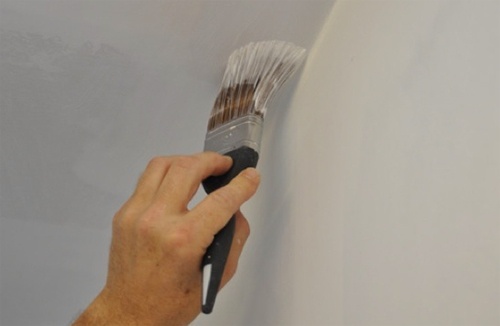
It is all, otherwise the spotting will remain. This technique is considered effective if you applied 1-2 layers. But if more layers are applied, in this case the price of the acrylic ceiling doubles, because you will have only one way out: a complete alteration, which includes grinding, putty and directly new painting of the ceiling.
Thus, you got acquainted with the advantages of acrylic colors. They differ by the type of purpose. There are dyes for ordinary rooms and rooms where high moisture resistance is needed. It is not recommended to use moisture -resistant paint, which is designed for wet rooms, in dry rooms. This is primarily due to its high price.

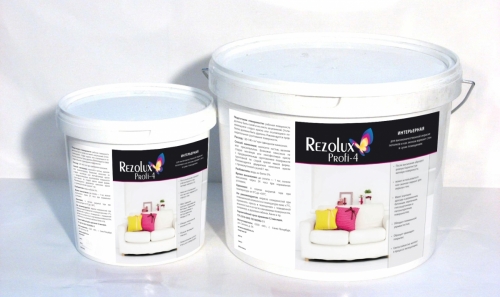
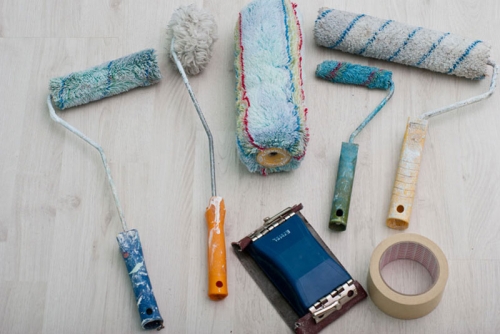
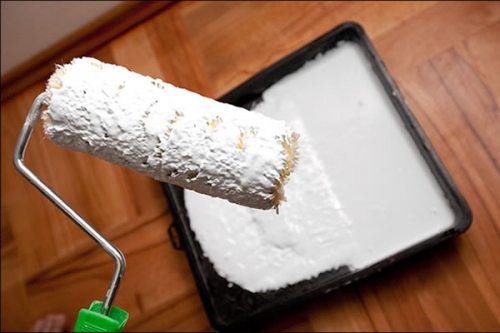


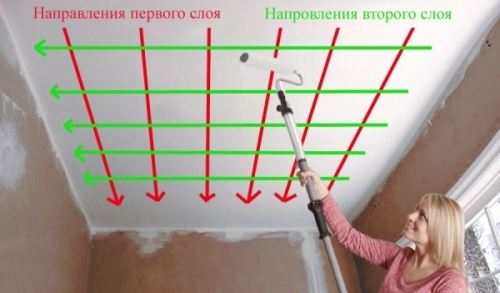
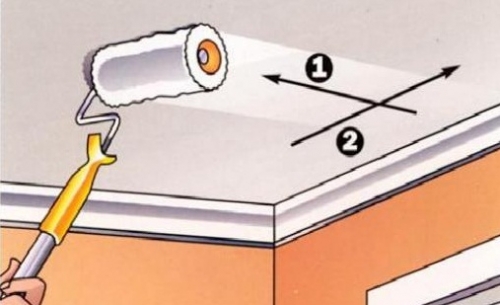
Copy -paste nonsense. Half
Copy -paste nonsense. Half of explanations are incomprehensible